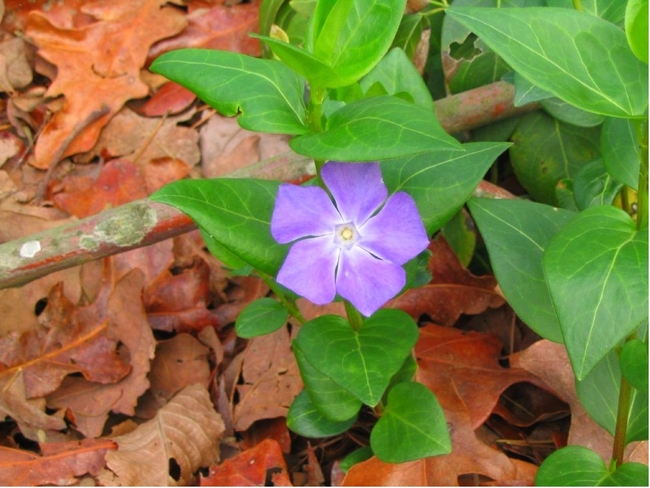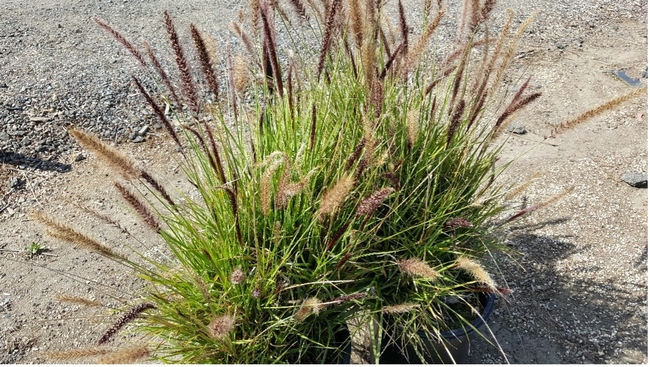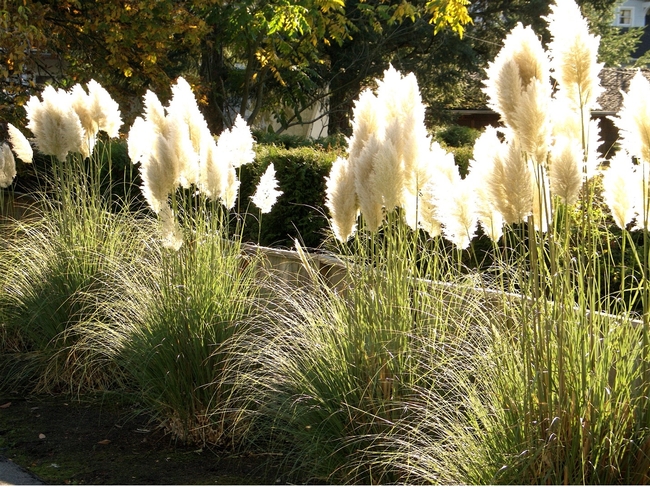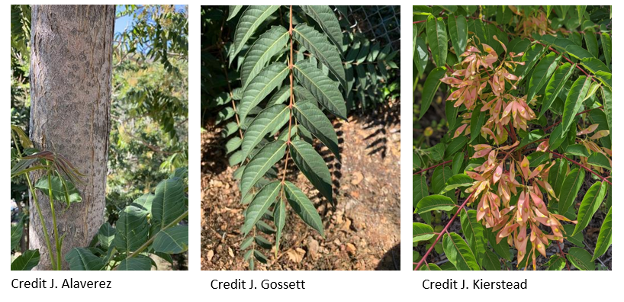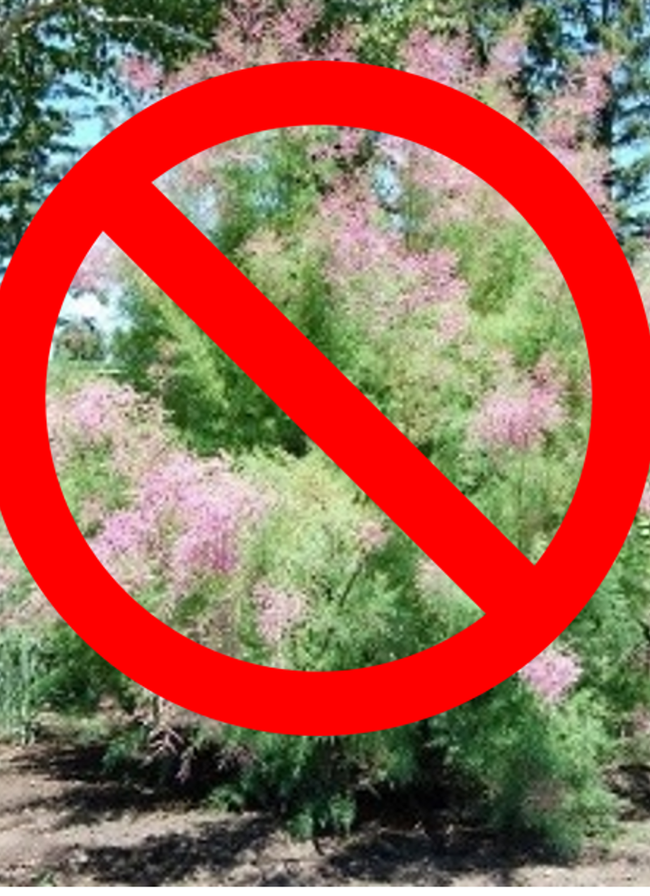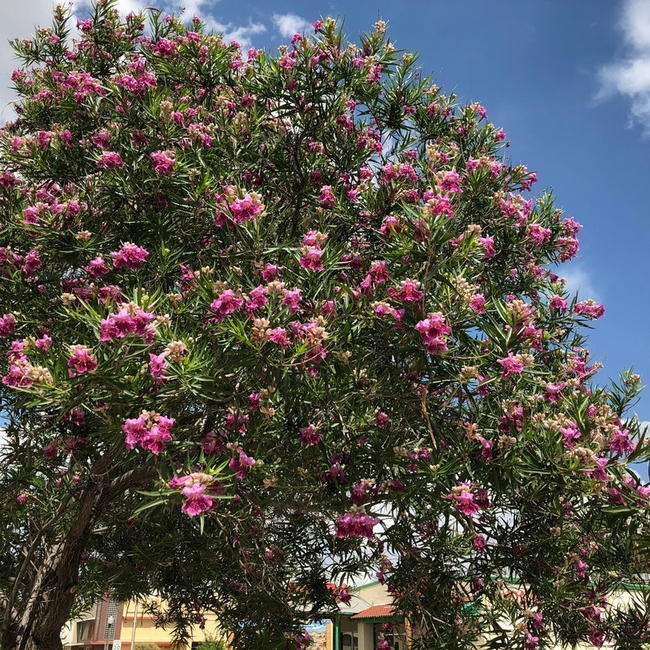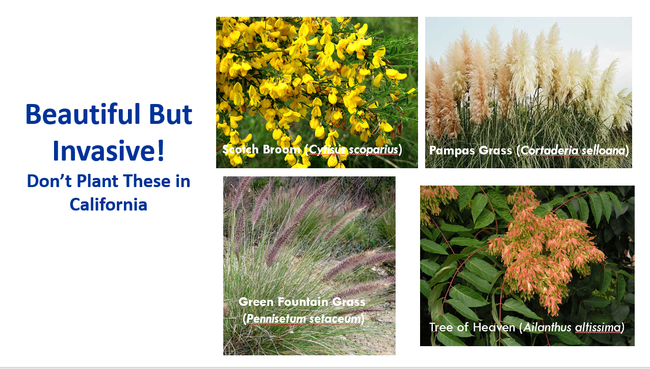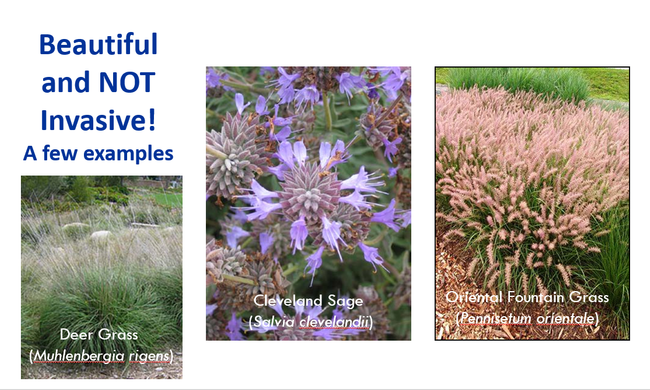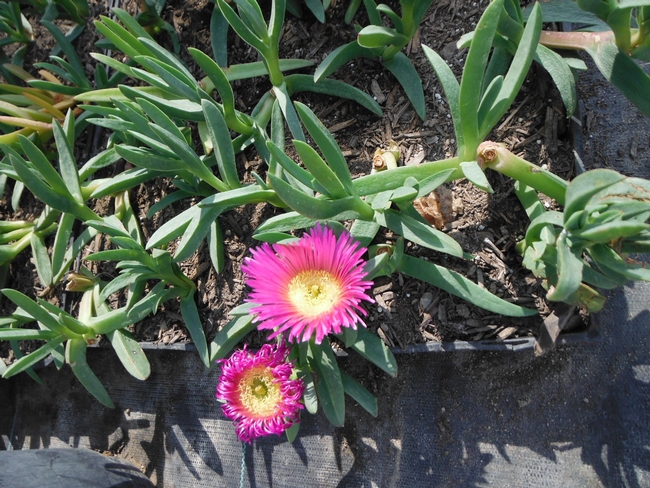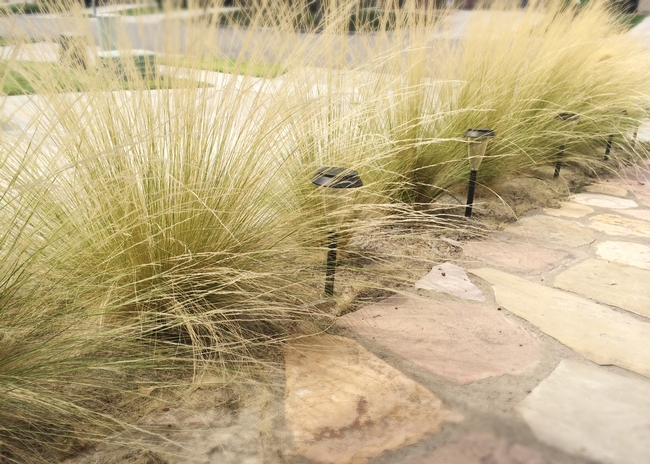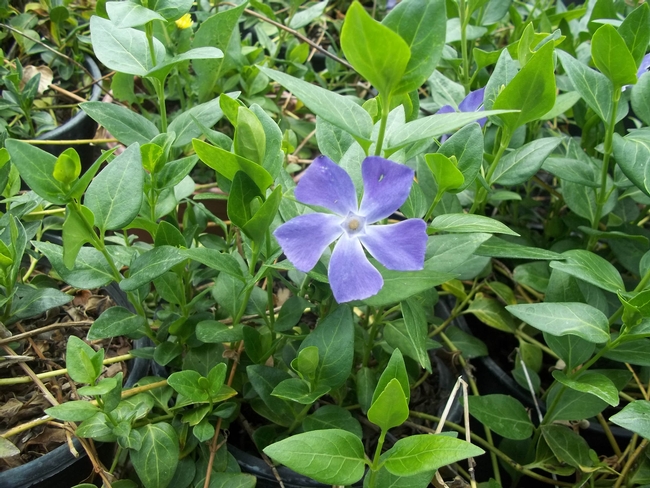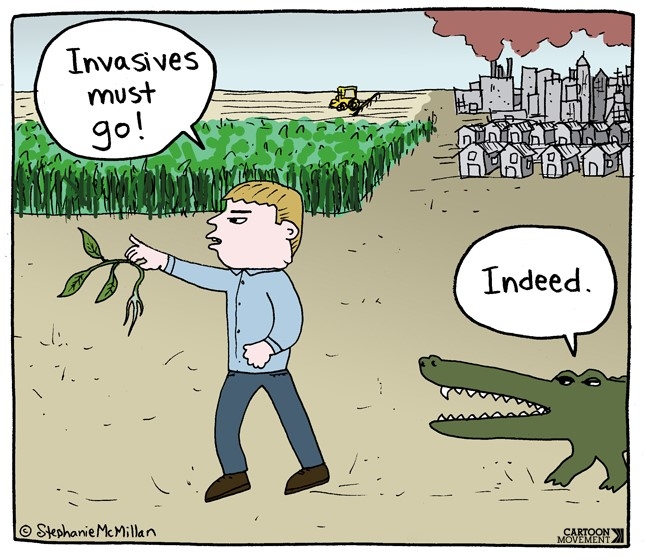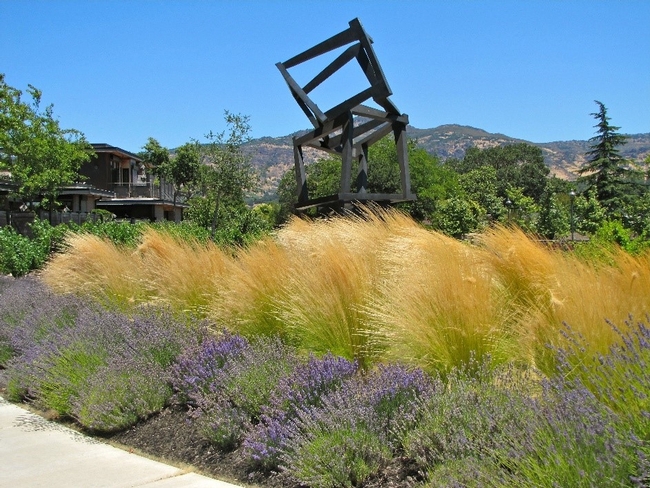Posts Tagged: Invasive
California Invasive Species Week: Say No to Invasive Plants and Garden for a Greener California
As California Invasive Species Week (June 3-11) approaches, it's time to raise awareness about the impact of invasive plants on our natural ecosystems and the importance of making informed plant choices. Invasive species can have detrimental effects on local flora and fauna, often outcompeting other plants for resources and disrupting local ecosystems. By selecting plants that are well-suited to your environment and not invasive, you can make a positive contribution to preserving California's diverse landscapes.
Many invasive plants can be aesthetically pleasing and low-maintenance, making them a popular choice for gardeners. However, invasive plants can spread rapidly, taking over natural habitats and causing significant environmental damage. Invasive species often have few natural predators, enabling them to grow uncontrollably and outcompete other plants for resources like water, sunlight, and nutrients. This can lead to the loss of biodiversity, reduced habitat quality for wildlife, and increased risk of erosion and wildfires.
Examples of Invasive Plants in California:
1. Periwinkle (Vinca major) - This evergreen groundcover is a popular species because of its beautiful purple blooms. Periwinkle forms dense mats that can smother native plants and alter soil chemistry. Instead of periwinkle, try planting native groundcovers like California lilac (Ceanothus spp.) or hummingbird sage (Salvia spathacea).
2. Fountain grass (Pennisetum setaceum) - This ornamental grass is highly adaptable and has invaded many natural habitats, including grasslands and coastal sage scrub. Instead, opt for native grasses like purple needlegrass (Stipa pulchra) or deergrass (Muhlenbergia rigens or the smaller version Muhlenbergia dubia).
3. Pampas grass (Cortaderia selloana) - A tall, clumping grass with feathery blooms that can quickly dominate landscapes and outcompete native species. Consider planting native ornamental grasses such as blue grama grass (Bouteloua gracilis) or switchgrass (Panicum virgatum) as alternatives to pampas grass.
4. Tree of heaven (Ailanthus altissima) - This fast-growing tree can release chemicals that inhibit the growth of other plants and can sprout vigorously from root fragments. Plant California native trees like sycamore (Platanus racemosa) or western redbud (Cercis occidentalis) instead of the invasive tree of heaven.
As we celebrate California Invasive Species Week, remember the importance of choosing native plants for your garden. By doing so, you can preserve biodiversity, and contribute to the overall health of our communities. The UC Master Gardener Program is a resource for guidance and education in sustainable gardening practices, including the selection of non-invasive plants. By working together, we can protect California's rich and diverse landscapes for generations to come. To learn more about mindful plant selection and how to create a beautiful, sustainable, and environmentally-friendly garden, visit the UC Master Gardener Program at mg.ucanr.edu/findus. Connect with your local UC Master Gardener Program, and access a wealth of gardening information tailored to your local climates and ecosystems.
Additional Resources:
- California Invasive Plant Council (Cal-IPC) - https://www.cal-ipc.org/ - Cal-IPC is a leading organization dedicated to protecting California's wildlands from invasive plants through research, restoration, and education.
- California Native Plant Society (CNPS) - https://www.cnps.org/ - CNPS is a non-profit organization that promotes the understanding and appreciation of California's native plants and preserves them in their natural habitat.
- PlantRight - https://plantright.org/ - PlantRight works with California's nursey industry to keep invasive plants out of our landscapes and promotes the sale of non-invasive alternatives.
Help keep the conversation going during California Invasive Species Week by sharing your native plant success stories on social media using the hashtag #CAInvasiveSpeciesWeek. Participate in local events, workshops, and volunteer opportunities to increase awareness and take action against invasive species in your community. Together, we can make a difference and preserve California's unique and vibrant ecosystems for future generations!
Invasive Trees to Avoid/Suggested Alternatives
Many previously “welcomed” urban tree species have outlived their stay, becoming invasive and crowding out other plants in our Southern California landscapes. You can help by avoiding planting these trees identified by various sources (including the California Invasive Plant Council) to be too aggressive and habitat/resource-depleting for further planting.
Invasive Trees to Avoid Planting
Athel (Tamarix aphylla)
Black Locust (Robinia pseudoacacia)
Blackwood Acacia (Acacia melanoxylon)
Brazilian Pepper (Schinus terebinthifolius)
Chinaberry (Melia azedarach)
Chinese Tallow Tree (Triadica sebifera)
English Hawthorn (Crataegus monogyna)
Peruvian Pepper Tree (Schinus molle)
Red Gum (Eucalyptus camaldulensis)
Russian Olive (Elaeagnus angustifolia)
Saltcedar (Tamarix ramosissima, T. gallica, T. chinensis)
Silver Wattle (Acacia dealbata)
Smallflower Tamarisk (Tamarix parviflora)
Tasmanian Bluegum (Eucalyptus globulus)
Plant These Instead
They are drought/heat resistant, low maintenance, and have no known significant pest or disease problems and are not currently overplanted). Find other suggestions here: https://www.cal-ipc.org/solutions/prevention/landscaping/dpp/?region=socal
African Fern Pine (Afrocarpus falcatus) (formerly Podocarpus elatior)
Cascolote (Caesalpinia cacalaco Smoothie®)
Desert Willow ‘Bubba' (Chilopsis linearis)
Fringe Tree (Chionanthus virginicus)
Island Oak (Quercus tomentella)
‘Maverick' Mesquite (Prosopis glandulosa)
Mulga (Acacia aneura)
Netleaf Hackberry (Celtis reticulata)
Pink Chitalpa (x Chitalpa tashkentensis 'Pink Dawn')
‘Red Push' Pistache (Pistacia x ‘Red Push')
Thornless South American Mesquite (Prosopis x Phoenix)
Invasive Plants: Don't Encourage 'Bad Neighbors'
What do ice cream, potato chips, Scotch and Spanish Broom, and Tree of Heaven have in common? While they're all tempting to indulge in, less is more. In fact, plants such as Scotch, Spanish Broom, Tree of Heaven, Pampas Grass, Green Fountain Grass, and dozens of plants are all considered invasive plants in California. Simply put, they should not be planted. There are some great alternative plants that are better choices listed at the end of this blog.
Truth be told, I admit to falling madly in love with the Spanish Broom (Spartium junceum) shrubs adorning Highway 18 on my drive from San Bernardino to Lake Arrowhead in early spring 1984 right after my job interview for my current position. Being a “wet behind the ears” recently hatched graduate student from the Midwest I was truly in awe of their lovely yellow blooms and vowed to plant one if I got the chance to move to California. Fortunately, I found out very soon that, while the plantings were made on purpose, they were a mistake and needed to be removed due to their invasive nature.
While they were ‘recruited' from Europe and had what seemed like a perfect resumé (fast growth, lovely yellow flowers, adaptability to poor infertile soil and disease and insect-resistance), they didn't play well with others, a fatal flaw. In California, they were aggressive and crowded out native plantings. Fires only exacerbated the situation. After the 2003 burns, the Spanish Broom populations exploded, obliterating any remaining natives and taking an even larger area hostage. In summer 2010, the San Bernardino National Forest removed the plants in a costly but necessary $500,000 project under a partnership with the American Recovery and Reinvestment Act. Constant monitoring continues in the San Bernardino Mountains and other areas of the state to prevent its reestablishment which is challenging due to its ability to quickly resprout, seed longevity, and effective dispersal. It has definitely earned its ‘noxious weed' label!
This is just one example of the problems posed by invasive plants. In effect, they grow too well! They outcompete desirable plants in our gardens, lawns, and other urban and natural areas for water, nutrients, and space. They also shade sun-requiring plants. Threatened and endangered plant species and other California native plants are particularly vulnerable to their encroachment. (In most cases, invasive plants are non-native species.) Interestingly, our beloved state flower, the California poppy, is an invasive plant in New Zealand, Hawaii and other locations outside of California.
As urban gardeners, we can all greatly reduce the impact of the encroachment of invasive plants in our urban environments. Please don't plant invasive sane remove plantings on your property to stop their spread. Below are some great resources to learn more about invasive plants and find viable replacements:
California Invasive Plant Council: https://www.cal-ipc.org/
Don't Plant a Pest: https://www.cal-ipc.org/solutions/prevention/landscaping/dpp/
Invasive Plants of Southern California:https://www.cal-ipc.org/solutions/prevention/landscaping/dpp/?region=socal
PlantRight: https://plantright.org/about-invasive-plants/plant
California Invasive Species Action Week – Let’s work together to be better, do better, and grow better.
Words like 'invasive plants' or 'weeds' often have a negative connotation for a good reason. Both words describe plants growing where they are not wanted or welcome. Plants that have a propensity to spread quickly result in habitat loss for native plants, insects, birds, and other animals. This is incredibly destructive to our natural environment and the landscape that Californians love to call our own.
Fast spreading invasive plants can quickly and dramatically change a plant community from a diverse one to a monoculture. When these plant communities shift, wildlife loses food, water and shelter resources and are forced to move out or perish.
Unfortunately, this description is not an over-dramatization. As Californians, we must communicate frankly about the impact of invasive plants in our environment. This is an important issue that can easily grow out of control. One of the biggest challenges with invasive plants is that they oftentimes have desirable features, like beautiful flowers or a spreading habit that quickly covers a barren patch in a home landscape.
Well-intentioned people have sold, purchased, propagated, and harvested plants that are known to be invasive. When done so knowingly, the gardener may use the excuse that they will watch the plant and not let it get out of control. Unfortunately, there is no way to monitor a plant that is distributed by wind, birds and other sources. It may be possible to monitor that your plant doesn't ‘escape' to the neighbor's garden but what about the seeds that blew off in the wind and established on a hillside two miles away?
Paying attention to signage and programs that identify invasive plants is an important part of caring for our environment. When questions about weeds and invasive plants arise, the UC Master Gardener Program is available locally to support good decisions and help us all be stewards of a healthy California.
Trained and certified volunteers utilize the vast network of information and expertise of the University of California to support gardeners and concerned citizens. You can reach your local county program online at mg.ucanr.edu/FindUs/.
It's Invasive Species Action Week – let's work together to be better, do better, and grow better.
California Invasive Plant Resources:
- Cal-IPC
- Plant-Right
- California Department Fish and Wildlife
- Weed Research & Information Center (UC ANR)
- UC Integrated Pest Managment
Spend your lunch learning about invasive species. Brought to you by UC Agriculture and Natural Resource and the California Invasive Plant Council, come hear from the experts about emerging tree pests, aquatic invasive species, and invasive weeds and fire.
Invasive Species Lunchtime Talks:
- Shot hole borers and other threats to California's trees (June 5, 12:10 - 1pm)
- Quagga mussels, nutria and other threats to California's water bodies (June 6, 12:10 - 1pm)
- Invasive plants and fire in California (June 7, 12:10 - 1pm)
Join from a PC, Mac, iPad, iPhone or Android device:
Please click this URL to join. https://ucanr.zoom.us/j/401190822
Or join by phone:
Dial(for higher quality, dial a number based on your current location):
US: +1 (646) 558-8656 or +1 (669)900-6833
Webinar ID: 401 190 822
Little Less Conversation, Little More Action (Please)
I saw Elvis today.
Actually, he's quite the regular at Sustainable Conservation's San Francisco headquarters these days. More than a titan among musical icons “The King” has become a muse to the PlantRight team, especially this National Invasive Species Awareness Week . We love Elvis' “A Little Less Conversation” because it might as well be our theme song for actionable awareness. We can't guarantee you'll be dancing along by the end of this article, but we do guarantee providing you with a few awareness-raising resources, a deeper understanding of what's holding back the hold-outs from taking positive action, and most importantly what we can do about it.
PlantRight defines “actionable awareness” as what happens when individuals and businesses are made aware of an opportunity to be part of the solution to California's costly (economically and environmentally) invasive garden plant problem, and make a conscious decision to act. Invasive plants (despite the fact that many are deceptively beautiful and drought resistant) outcompete native plants, alter soil chemistry, increase wildfire risk, clog our waterways and can severely compromise agricultural yields and real estate value. If that weren't enough, invasive species are the second greatest threat to biodiversity after human development.
Awareness of these facts alone will not fix any of these issues; however, add action to the mix and you have a proven formula for problem solving. PlantRight's idea of problem solving is collaborating with the industry to voluntarily phase invasive plants out of the supply chain and replace them with high-quality (i.e. non-invasive) plants. Voila! Together we prevent new invasive garden plants from wreaking havoc on our wild lands and taxpayer wallets.
A Little Less Conversation, a Little More Action Please
The fact that 50% of California's invasive plants are of horticultural origin (Bell et al. 2007) is a source of both conversation and dismay. Yet from PlantRight's perspective this 50% is a great source of optimism because it's proof of a huge opportunity the nursery industry can play in preventing future invasive plant introductions. In past decades ornamental plant breeders and growers had little or no ability to predict a plant's invasive risk in a given region, and most invasions were well-intentioned accidents. Lucky for us we finally have science-based plant risk evaluation tools to prevent new invasive plant introductions. Not so lucky for us is that popular plants travel, and a delightful Dr. Jekyll plant in one region, may become a hideous Mr. Hyde plant and landscape transformer in a different region. It's about the right plant in the right place, but just where to begin, if we're to turn this talk into actionable awareness?
In the beginning there was lots of conversation and lots of listening sessions that Sustainable Conservation conducted with a diverse group of nursery industry stakeholders, from large ornamental growers, retail nurseries, plant scientists, trade associations and government agencies. University of California Agriculture and Natural Resources (UC ANR) has been part of this group from the start, providing academic expertise on weeds and calculating their risk. This group's official moniker is “California Horticultural Invasive Prevention,” but we prefer Cal-HIP.
With a couple years of listening and learning under our belts, and funding from Sustainable Conservation, the PlantRight program was ready for action: action engaging the nursery industry in voluntarily phasing our invasive ornamental plants and promoting, in their place, non-invasive alternatives.
Our first order of business was to measure the scope of the problem and establish a baseline. Working closely with plant science experts to identify the most problematic invasive ornamental plants, and industry experts to identify non-invasive alternatives, we created our first PlantRight plant list. If you can measure it you can manage it, we like to say - to do this, we rely on an annual Spring Nursery Survey. Each spring, partner with UC Master Gardener volunteers to survey more than 200 nurseries and garden centers around the state, and in the process track the retail market for invasive garden plants in California.
Along with informing PlantRight's program strategy, the annual survey allows us to keep PlantRight's plant list manageable and up to date – we add new invaders and retire those that are largely phased out of the trade. It is our program's calling card, and the starting point for conversations with prospective partners and skeptics, alike. It has earned the enthusiastic support of California Certified Nursery Professionals (CCNPro), SaveOurWater, and more.
A Little Less Fight, a Little More Spark
Buying non-invasive means many things, including protecting native species, being good stewards of our beautiful open spaces and waterways, being fiscally responsible and preventing additional taxpayer dollars going to avoidable invasive plant eradication efforts. Buying non-invasive plants is casting a vote for the kind of world you want to live in.
So, why on earth do people buy invasive plants in the first place? (Hint: One big reason has to do with what happens when you turn off the lights). Yep, people who purchased invasive plants were in the dark – they did not know.
In 2013, we learned that the primary drivers behind consumer purchases of invasive plants are: 1) aesthetics – it looks good; and, 2) there was no information on the plant indicating “invasive.” In other words the majority of invasive plant purchases (by consumers) are impulse purchases and would not have occurred had the plant been properly identified as “invasive.”
Nan Sterman, award winning garden writer and host of PBS' “A Growing Passion,” has her own answer to this vexing invasive plant question. “It's about visual influence,” says Sterman. “People tend to buy and plant what they see in their local gardens and landscapes. “ According to Sterman, these include the very people who religiously recycle, buy high-efficiency appliances, and drive electric cars, yet they can't imagine beautiful, drought tolerant plants posing environmental problems. Nassella tenuissima, or Mexican feathergrass, is one such culprit that has been romancing many well-intentioned Californians.
Come On, Come On…Come On, Come On
Ready to channel your inner Elvis and tackle invasive garden plant problems in ways that make economic sense? (Of course you are!) Here are a few resources to empower more action in your community.
- Share this article
- Sign up for the Spring Nursery Survey Webinar and Training
- View our Plant List at PlantRight.org
- Invasive Plant IQ Test
- View our 2016 Invasive Plants Webinar
- Little Less Conversation, Little More Action (Please) - Video
So this National Invasive Species Awareness Week we encourage you to crank up that volume and bust a move with the PlantRight community (blue suede shoes optional), knowing that YOU are driving actionable awareness…this week, this month and in the years ahead.
Thank you, thankyouverymuch.





